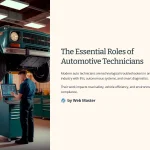 In the ever-evolving world of automotive maintenance, understanding key terms is crucial for both professionals and enthusiasts. This comprehensive guide delves into essential automotive maintenance terminology, providing clear definitions and insights to enhance your automotive literacy.
In the ever-evolving world of automotive maintenance, understanding key terms is crucial for both professionals and enthusiasts. This comprehensive guide delves into essential automotive maintenance terminology, providing clear definitions and insights to enhance your automotive literacy.

Engine Components
A vehicle’s engine comprises various components working in unison to ensure optimal performance. Familiarity with these parts is fundamental for effective maintenance and troubleshooting.
- Cylinder: The chamber where fuel combustion occurs, driving the piston.
- Piston: A cylindrical component that moves up and down within the cylinder, converting fuel combustion into mechanical motion.
- Crankshaft: Transforms the piston’s linear motion into rotational motion, transmitting power to the drivetrain.
- Camshaft: Controls the opening and closing of engine valves, synchronizing with the crankshaft to ensure proper timing.
- Timing Belt/Chain: Maintains synchronization between the crankshaft and camshaft, ensuring valves open and close at appropriate times.

Fuel System Components
The fuel system stores and supplies fuel to the engine, playing a pivotal role in vehicle performance and efficiency.
- Fuel Tank: Stores gasoline or diesel fuel until it’s needed by the engine.
- Fuel Pump: Transfers fuel from the tank to the engine, maintaining appropriate pressure for optimal performance.
- Fuel Injector: Sprays a fine mist of fuel into the engine’s combustion chamber for efficient combustion.
- Carburetor: (In older vehicles) Mixes air and fuel before delivering it to the engine; largely replaced by fuel injectors in modern cars.

Ignition System Components
The ignition system initiates the combustion process, igniting the air-fuel mixture to start the engine.
- Spark Plug: Delivers an electric spark to ignite the air-fuel mixture in the combustion chamber.
- Ignition Coil: Transforms the battery’s voltage to a higher voltage needed to create a spark in the spark plug.
- Distributor: (In older vehicles) Routes high-voltage electricity from the ignition coil to the correct spark plug at the right time.
Cooling System Components
To prevent engine overheating, the cooling system regulates temperature by dissipating excess heat.
- Radiator: Disperses heat from the coolant into the air, lowering the coolant’s temperature.
- Water Pump: Circulates coolant through the engine and radiator, facilitating heat exchange.
- Thermostat: Regulates coolant flow based on engine temperature, ensuring optimal operating conditions.
- Coolant/Antifreeze: A fluid that absorbs engine heat and prevents freezing in low temperatures.


Lubrication System Components
Proper lubrication reduces friction between moving parts, extending engine life and enhancing performance.
- Engine Oil: Lubricates engine components, reduces friction, and aids in cooling.
- Oil Filter: Removes contaminants from engine oil, maintaining its effectiveness.
- Oil Pan: Stores engine oil at the bottom of the engine before it’s circulated.

Transmission Components
The transmission system transfers engine power to the wheels, allowing the vehicle to move at varying speeds.
- Transmission: Adjusts the engine’s output to the drive wheels, enabling different speed and torque ratios.
- Clutch: (In manual transmissions) Engages and disengages the engine from the transmission, allowing gear changes.
- Torque Converter: (In automatic transmissions) Transfers rotating power from the engine to the transmission.
Conclusion
A solid grasp of automotive maintenance terminology empowers vehicle owners and professionals to communicate effectively, perform accurate diagnostics, and ensure optimal vehicle performance. Regularly updating your knowledge in this field is essential, given the continuous advancements in automotive technology.
Q&A
Q: Why is understanding automotive maintenance terms important?
A: It enables effective communication with professionals, accurate vehicle diagnostics, and informed maintenance decisions.
Q: How often should I familiarize myself with new automotive terms?
A: Regularly, as the automotive industry continually evolves with new technologies and components.
Q: Where can I find reliable information on automotive maintenance?
A: Official vehicle manuals, reputable automotive websites, and certified automotive professionals are excellent resources.
Final Thoughts
Staying informed about essential automotive maintenance terms not only enhances your understanding but also contributes to the longevity and reliability of your vehicle. Em
*Capturing unauthorized images is prohibited*


